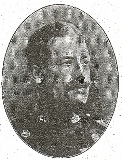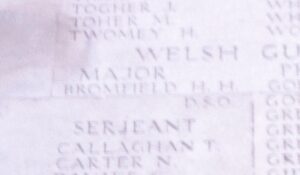Dyfed Powys Police War Memorial, 1914-1918
Dyfed Powys Police force was formed in 1968 with the merger of the County Constabularies of Carmarthen, Pembroke, Cardigan, Brecon, Radnor and Montgomery. A large number of Policemen from the old county police forces served in the armed forces during the Great War, sixteen of whom lost their lives. These men were originally commemorated on war memorials in their respective counties, but during 2014 Dyfed Powys Police decided to commemorate all of its former men on a new war memorial which was unveiled in the Police HQ at Llangunnor and the new memorial, which had been researched by Kevin Smith, was unveiled on Friday 28 November 2014.
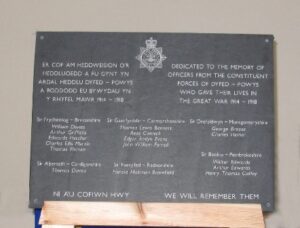
Breconshire Constabulary
William Davies, Lance Corporal, 37119, Royal Welsh Fusiliers. William was the son of David and Elizabeth Ann Davies, of Gilestone Cottage, Talybont-On-Usk, Breconshire. He had served as a Policeman at Brecon and Brynmawr prior to the war and enlisted at Brecon into the Royal Welsh Fusiliers. He was posted to France early in 1916, joining the 2nd Battalion, Royal Welsh Fusiliers, which was attached to 19 Brigade, 33rd Division. During the evening of 21 June 1916, the 2nd RWF moved into trenches at Givenchy. At around 01.40 on the morning of 22 June 1916, a terrific explosion brought terror to the men posted in the trenches. The Germans had blown a mine beneath the line held by B Company of the 2nd RWF, engulfing two-thirds of its men in tons of earth and debris. William was one of many men killed during the explosion, both above and below ground. He was 25 years old and is commemorated on the Loos Memorial, France, as his body was never recovered. The crater was later named the Red Dragon Crater, in honour of the 2nd RWF who defended the position against the resulting German attack.
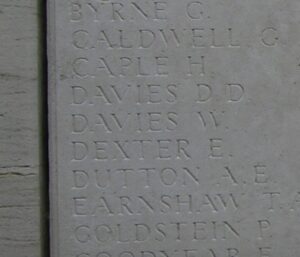
Arthur Allen Griffiths, Lance Corporal, 1319, Welsh Guards. Arthur was the son of Jeremiah and Mary Griffiths, of 3, Bridge Villa, Credenhill, Hereford. He had served with the Grenadier Guards prior to 1900 when he enlisted into the Gloucester Regiment. He embarked for South Africa with the regiment in 1900, and saw action during the Boer War, then served in India until returning to England again in 1908. In 1912 he left the army to join the Breconshire Constabulary and served as a Policeman at Brecon, Builth and Hay prior to the war. He enlisted there into the 1st Battalion, Welsh Guards. The Regiment was raised by Royal Warrant of 26 February 1915, at White City, before landing at Le Havre on 18 August 1915, becoming attached to 3rd Guards Brigade, Guards Division. The Division saw its first major action during the Battle of Loos on 25 September 1915, remaining in the area during the coming months, where they also fought in the subsequent Action of Hohenzollern Redoubt. In July 1916 the Division moved to the Somme, where they fought at the Battle of Flers-Courcelette, and then at the Battle of Morval, capturing Lesboeufs Village. They remained here for the winter, and followed up the German withdrawal to the Hindenburg Line the following spring. Arthur was killed in action by a shell along with two other men while carrying out wiring repairs in No Man’s Land on 5 March 1917. He was 33 years old and is buried in Sailly-Saillisel British Cemetery, France.
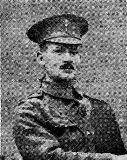
Edward Hatcher, Guardsman, 1321, Welsh Guards. Edward was the son of Edward and Annie Hatcher, of Appleshaw Street, Appleshaw, Hampshire. He had served as a Policeman at Brecon and Llanwrtyd Wells prior to the war and enlisted at Brecon into the 1st Battalion, Welsh Guards. He married Elizabeth Mary Williams of Llyswen whilst home on leave on 5 August 1916. He joined the battalion, which was attached to the 3rd Guards Brigade, Guards Division, in France during the summer of 1916, in time to take part in the Battle of the Somme. On the night of 8 September 1916 the Welsh Guards moved passed Cuinchy through Guillemont towards the front line, in preparation to take over the line on the following morning prior to the next phase of the offensive towards Leuze Wood. The situation was confusing, and the Guardsmen struggled to get to their proper positions, encountering strong German opposition during the morning. Edward was killed in action during heavy fighting on 10 September 1916. He was 28 years old and was buried in London Cemetery & Extension, Longueval, France.
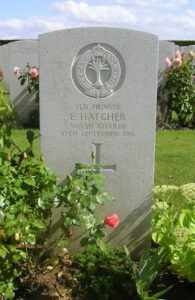
David John Joseph, Private, R4/307951, Royal Army Service Corps. David was the son of Price Joseph and Margaret Joseph (nee Williams), of Myrtle House, Llangammarch Wells. He worked as a groom prior to enlisting into the Breconshire Constabulary as a young man and was posted at Crickhowell Police Station. David married Gertrude Elsie Jones at Abergavenny on 24 June 1913 and the couple set up home at the Police Station. David enlisted into the Army Service Corps (Remounts) at Bristol on 29 September 1915 and was posted to the Depot at Shirehampton. On 29 August 1916 he was posted to the 60th Remount Squadron at Bulford, but about six months later began suffering with his health. David was hospitalised at Bulford where he was found to be suffering from phthisis, contracted during his service, and he was discharged from the army as medically unfit on 18 June 1917, with a full pension. He returned home to his wife at Crickhowell and died there of tuberculosis on 18 February 1919. The remains of the 31-year-old were buried with his father in Llanlleonfel Churchyard, Garth. David is not commemorated as a casualty by the CWGC, nor is he commemorated on the Breconshire Constabulary War Memorial.
Charles Ellis Martin, Gunner, 57582, Royal Garrison Artillery. Charles was the son of Job and Sarah Martin, of 30, Oakland Cottage, Llanddewiricwm, Brecon. He had served with the Brecknockshire Battalion, South Wales Borderers (Territorials) from 1908 until 1912 and had served as a Policeman at Brynmawr prior to the war. He enlisted there into the Royal Garrison Artillery alongside his friend and colleague PC Thomas Henry Pitman. Charles was posted to France early in 1916, joining ‘Y’ 34th Trench Mortar Battery, Royal Garrison Artillery. He served during the Somme offensive that summer, and towards the end of 1916 returned home to Brynmawr on two weeks leave. Charles had only been back in France a week when he was mortally wounded, and died on 16 January 1917 aged 23. He is buried in Hazebrouck Communal Cemetery, France.
Thomas Henry Pitman, Corporal, 57583, Royal Garrison Artillery. Thomas was born at Fishguard in 1895, the son of Henry and Winifred Pitman. His father had been a long serving Petty Officer, and after retirement had moved the family to Dorset House, Cwmllynfell by 1901. Thomas had served as a Policeman at Brecon and Builth Wells prior to enlisting at Brecon into the Royal Garrison Artillery. He was posted to the 5th/6th Trench Mortar Battery. Not much is known of Thomas’ service on the Western Front, but he had been on active service for over two years when he was killed in action after being struck by shell fragments on 9 May 1918, aged 23. He was originally buried in Blairville Orchard British Cemetery, but in 1923 all of the graves in the cemetery were exhumed and relocated to Cabaret-Rouge British Cemetery, Souchez, France.
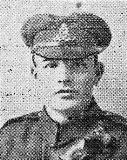
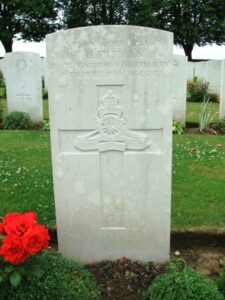
Cardiganshire Constabulary
Thomas Davies, Private, 1446, Welsh Guards. Thomas was the son of John and Mary Davies, of Rhydgalfe, Llandyssul. He was a Police Constable at Aberystwyth prior to the war and enlisted there into the 1st Battalion, Welsh Guards, which had been formed by Royal Warrant of 26 February 1915. They landed at Havre on 8 August 1915, where they were attached to the 3rd Guards Brigade, Guards Division, and saw their first action at the Battle of Loos the following month. Thomas was killed in action at Hill 70, Loos on 27 September 1915, aged 23. He has no known grave, and so is commemorated on the Loos Memorial, France.
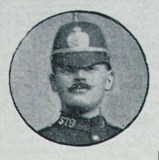
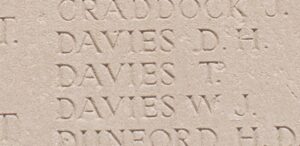
Carmarthenshire Constabulary
Thomas Lewis Bennett, Sapper, 175528, Royal Engineers. Thomas was born at Kidderminster in 1894, the son of Thomas and Elizabeth Bennett. The family had moved to the School House, Ferryside prior to the outbreak of war, where Thomas became a Policeman, and his father ran his own grocery business. Thomas enlisted at Carmarthen into the Pembroke Yeomanry in December 1914, and on 18 June 1916 transferred into the Royal Engineers. He was posted to France, and served as a Sapper in 174 Tunnelling Company from 8 July 1916. This Tunnelling Company served on the Western Front throughout the war, and Thomas joined them on the Somme. By October 1916,174 Tunnelling Company had moved north of the Ancre, facing Beaumont-Hamel, before following the German withdrawal in 1917 towards the Cambrai area. Thomas was killed in action here on 20 November 1917, during the Battle of Cambrai. He was 23 years old and was buried in Croisilles Railway Cemetery, France. His grave was lost during the battle but as he was definitely known to have been buried in the cemetery, Thomas is now remembered by a Special Memorial there. His parents later moved to the Red Lion Hotel, Drefach, Henllan.
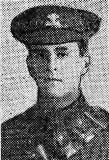
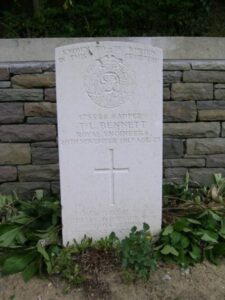
Rees Connick, Stoker, K/53680, Royal Navy. Rees was born on 16 April 1892, the son of Thomas and Ann Connick, of 31, Mysydd Terrace, Landore, Swansea. He had resided at Llanelli prior to the war, working for the GWR before becoming a policeman, based in Llanelli. In July 1918 Rees was released from his duties to join the Royal Navy. He was based at HMS Vivid, but within weeks had taken ill, and died of pneumonia at Plymouth on 20 September 1918. He was 26 years old, and is buried at Swansea (Cwmgelly) Cemetery.
William John Davies, Corporal, 3244, Welsh Guards. William was born in 1884, the son of Joseph and Elizabeth. Davies, Aberdauddwr, Lampeter. He served as a Policeman at Llanelli prior to the war and enlisted at Pembrey into the 1st Battalion, Welsh Guards, which was in France attached to the 3rd Guards Brigade, Guards Division. The Welsh Guards saw their first major action during the Battle of Loos on 25 September 1915, remaining in the area during the coming months, where they also fought in the subsequent Action of Hohenzollern Redoubt. In July 1916 the Division moved to the Somme, where they fought at the Battle of Flers-Courcelette, and then at the Battle of Morval, capturing Lesboeufs Village. They remained here for the winter, and in March 1917 took part in the advance caused by the German Retreat to the Hindenburg Line. Later that year they moved north to Ypres, where they fought at the Battle of the Pilkem, and then at the Battle of the Menin Road, Battle of Poelcapelle and the First Battle of Passchendaele. November saw them move south again, where they took part in the Battle of Cambrai. They remained in the area over the final winter of the war, and were stationed near Gouzeaucourt when William was killed in action on 26 February 1918. He was 33 years old, and is buried at Level Crossing Cemetery, Fampoux, France. William is not commemorated on the original Carmarthenshire Constabulary War Memorial or the new Dyfed Powys Police Memorial.
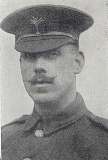
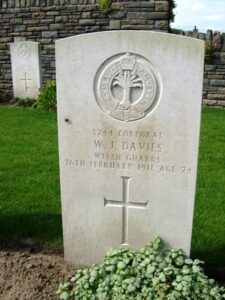
Edgar Emlyn Evans, Guardsman, 25838, Grenadier Guards. Edgar was the son of George and Sarah Evans, of Gwalia, Llandebie. He was a policeman prior to the war, and enlisted at Ammanford into the 2nd Battalion, Grenadier Guards. The battalion had been in France with the 3rd Division since the Battle of Mons, and had fought through the retreat to the Aisne. They had fought at First Ypres, and in August 1915 were attached to the newly formed 3rd Guards Brigade, Guards Division. The Division fought through the Battle of Loos, then at Flers and Morval during the 1916 Somme Battles, and saw much action at Third Ypres. They fought during the Battle of Cambrai and were in the area when the German Spring Offensive was launched on 21 March 1918. Edgar was killed in action during this traumatic period, on 4 April 1918, aged 25, and is buried at Bucquoy Road Cemetery, Ficheux, France.

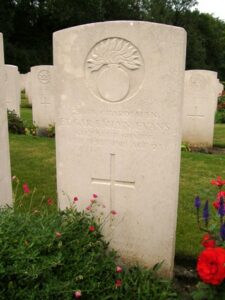
John William Farrell, Bombardier, W/5188, Royal Field Artillery. John was the son of John William and Eleanor Elizabeth Farrell, of Chelsea, London. He was a Police Constable at Ammanford prior to the war, and enlisted there into the Royal Field Artillery, serving with their ‘D’ Battery, 2nd Brigade. John was wounded at Ypres, during the Battle of Messines, and was evacuated to the Casualty Clearing Station at Proven, where he died of wounds on 10 June 1917, aged 25. He is buried at Mendinghem Military Cemetery, Belgium.
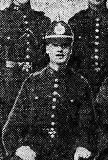
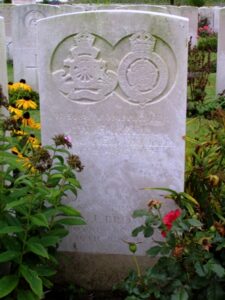
Ernest Edward Jenkins, Private, 235830, Lancashire Fusiliers. Ernest was the John and Emily Jenkins. He had been raised by his step-parents, Mr. and Mrs. Doward, of Hammersmith, London. Ernest was a policeman, and had been based at Llandeilo and at Llanelli prior to the war. He married Elizabeth Caroline Davey before transferring to Kenfig Hill with the Police. Ernest was posted to France at some time after 1916, joining the 2nd Battalion, Lancashire Fusiliers, which was attached to 12 Brigade, 4th Division. The division had seen heavy fighting throughout 1917, at Arras and at Ypres, before moving to the Arras sector to rest. It was among the division hit by the German spring offensive of 21 March 1918, and saw heavy fighting over the coming weeks. Ernest was killed on 19 April 1918, aged 36, and is buried in Lapugnoy Military Cemetery, France. His widow, Elizabeth, later remarried, and moved to 3, Laundry Cottages, Northfields, Ealing, London. Ernest is not commemorated on the new memorial.
Montgomeryshire Constabulary
George Breese, Private, 355441, Royal Welsh Fusiliers. George was the son of George Samuel and Martha Breese, of Dysgwlfa, Aberhafesp, Newtown, Montgomeryshire. He served as a Policeman at Newtown then at Welshpool prior to enlisting there into the Montgomery Yeomanry in July 1915 soon after marrying Margaret Eleanor Evans. He was first posted to Ireland, and in January 1917 was posted to Egypt to join the 25th Battalion, Royal Welsh Fusiliers, which was attached to 231 Brigade, 74th (Yeomanry) Division. The Division had formed in Egypt in January 1917 and had fought through the Palestinian Campaign, at the Battles of Gaza and the Battle and capture of Jerusalem. George was accidentally killed in Palestine on 22 November 1917, aged 28, and is buried in Deir El Belah War Cemetery, Israel.
Charles Hamer, Lance Corporal, 1770, Welsh Guards. Charles was the son of Richard and Sarah Hamer, of Llandinam, Montgomeryshire. He served as a Policeman at Newtown prior to enlisting there into the 1st Battalion, Welsh Guards. He joined the battalion, which was attached to the 3rd Guards Brigade, Guards Division, in France during the summer of 1916, in time to take part in the Battle of the Somme. On the night of 8 September 1916 the Welsh Guards moved passed Cuinchy through Guillemont towards the front line, in preparation to take over the line on the following morning prior to the next phase of the offensive towards Leuze Wood. The situation was confusing, and the Guardsmen struggled to get to their proper positions, encountering strong German opposition during the morning. Charles was badly wounded during heavy fighting on 10 September 1916 and died that same day. He was 32 years old and was buried on the battlefield where he fell. His grave was exhumed in 1919 and Charles was buried in Guards’ Cemetery, Lesbouefs, France.
Pembrokeshire Constabulary
Thomas Henry Coffey, Private, 31843, South Wales Borderers. Thomas was born in Bedwas in 1886, the son of George John Coffey and Mary Coffey (nee Morgans). Thomas had married Ethel Annie Fairfax in 1905. He had returned to his mothers native Pembrokeshire to serve as a Police Constable, first at Pembroke, and then at Tenby, taking his wife and five children. Thomas enlisted at Aldershot into the Military Foot Police, and later transferred into the 8th Battalion, South Wales Borderers, which was attached to 67 Brigade, 22nd Division. The Division landed at Boulogne on 6 September 1915, but were almost immediately ordered to proceed to Marseilles, embarking there on 30 October for Salonika. They remained here for the duration of the war, fighting in a disease ridden climate. Thomas died of dysentery at the 42nd General Hospital, Salonika on 6 September 1918, aged 32. He is buried at Salonika (Lembet Road) Military Cemetery, Greece.
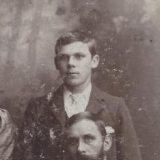
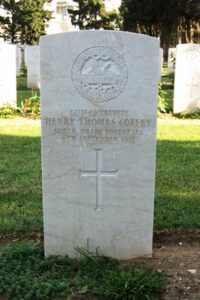
Arthur Edwards, MM, Bombardier, 64876, Royal Field Artillery. Arthur was born at Dale in 1893, the son of John and Catherine Edwards, of Hayguard Bay. Arthur served with Pembrokeshire Constabulary prior to enlisting at Cardiff into the Royal Field Artillery on 21 April 1911. At the outbreak of war was posted to France with the 112th Battery, 24th Brigade Royal Field Artillery, which was attached to the 6th Division. On 10 September 1914 the Division landed at St Nazaire and moved to reinforce the hard-pressed BEF on the Aisne, before the whole army was moved north into Flanders. Here the Division took part in the Action of Hooge during June 1915, and in 1916 moved to the Somme, where it fought at the Battle of Flers-Courcelette, the Battle of Morval and the Battle of Le Transloy. The following year saw it at Arras, where it fought at the Battle of Hill 70. Arthur came home on leave in the summer of 1917, and married Annie May Griffiths at Pembroke on 23 July 1917. He rejoined his unit in time to take part in the Battle of Cambrai later in the year. In the spring of 1918 the Division was one of those hit by the German Offensive on the Somme, which had been launched on 21 March 1918, and the Division took part in the Battle of St Quentin. Arthur was killed during the next few days terrible fighting around Achiet-le-Grand on 25 March 1918, aged 24. He has no known grave, and is commemorated on the Arras Memorial, France. Arthur had won the Military Medal for Bravery in the Field during his time on the Western Front, and the award was published in the London Gazette of 6 August 1918.
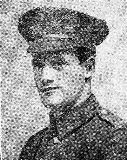
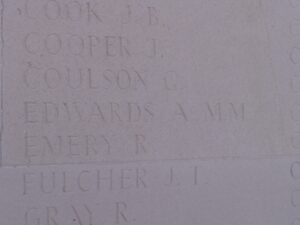
Walter Edwards, Private, 1750, Welsh Guards. Walter was the son of William and Susan Edwards, of Towns End, Dale. He enlisted at Haverfordwest into the Army, and was posted to the 1st Battalion, Welsh Guards. The Regiment was raised by Royal Warrant of 26 February 1915, at White City, before landing at Le Havre on 18 August 1915, becoming attached to 3rd Guards Brigade, Guards Division. The Division saw its first major action during the Battle of Loos on 25 September 1915, remaining in the area during the coming months, where they also fought in the subsequent Action of Hohenzollern Redoubt. In July 1916 the Division moved to the Somme, where they fought at the Battle of Flers-Courcelette, and then at the Battle of Morval, capturing Lesboeufs Village. They remained here for the winter, and in March 1917 took part in the advance caused by the German Retreat to the Hindenburg Line. Later that year they moved north to Ypres, where they fought at the Battle of the Pilckem, and then at the Battle of the Menin Road, Battle of Poelcapelle and the First Battle of Passchendaele. November saw them move south again, where they took part in the Battle of Cambrai. On 31 November 1917 the Welsh Guards were stationed at Havrincourt Wood, when a German counter-attack hit the area and smashed through the British lines. The Guards Division was ordered to secure Gauche Wood, and moved into positions there. The Welsh Guards attacked Gonnelieu the following day, but suffered heavy casualties during their attack. Walter was killed in action here on 1 December 1917, aged 27. He has no known grave, and is commemorated on the Cambrai Memorial, Louverval, France.
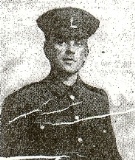
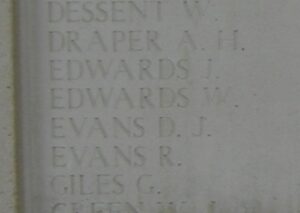
Radnorshire Constabulary
Harry Hickman Bromfield, DSO, Major, Welsh Guards. Harry was the son of Henry and Mary Elizabeth Bromfield, of Stratford-on-Avon. He married Ethel Philippa Philipps in 1906, the eldest daughter of Sir Charles and Lady Philipps of Picton Castle. Harry had served in the South African War as Captain in the South Wales Borderers, and had gained the Distinguished Service Order in South Africa for his gallant leadership. He had been the Chief Constable of Radnorshire Constabulary prior to the war and volunteered to serve with the newly formed Welsh Guards in 1915, joining the battalion at Esher. The 1st Battalion, Welsh Guards was attached to 3rd Guards Brigade, Guards Division, which had been formed in France in August 1915. It remained on the Western Front throughout the war and saw its first major action during the Battle of Loos on 25 September 1915, remaining in the area during the coming months, where they also fought in the subsequent Action of Hohenzollern Redoubt. In July 1916 the Division moved to the Somme, and Harry joined it here, when he took command of Prince of Wales Company from Viscount Clive, who had been promoted. On 14 August the battalion was relieved by the 2nd Battalion Scots Guards, and went into a variety of rest-huts, ruins, and trenches round Colincamps. The Guards then moved back into the line, taking over from 48 Brigade a line along the outskirts of the wood at the end of Ginchy. The situation at the time was a mess. The Welsh Guards were facing the wrong way, as they did not know what had happened during the previous attack, and in the ensuing fighting, Harry was killed while leading his men gallantly on 10 September 1916, aged 47. He is commemorated on the Thiepval Memorial, France.
